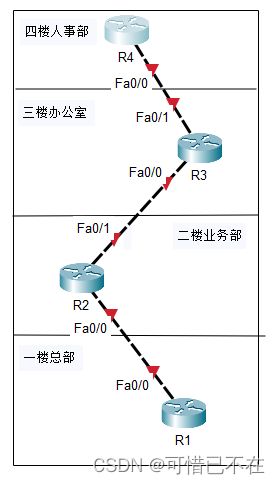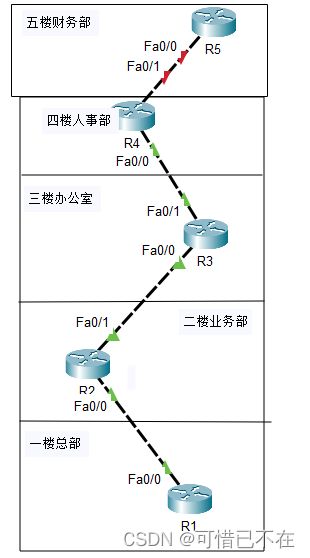【学网攻】 第(28)节 -- OSPF虚链路
系列文章目录
目录
系列文章目录
文章目录
前言
一、什么是OSPF虚链路?
二、实验
1.引入
实验目标
实验背景
技术原理
实验步骤
实验设备
实验拓扑图
实验配置
扩展
实验拓扑图
实验配置
实验验证
文章目录
- 【学网攻】 第(1)节 -- 认识网络
- 【学网攻】 第(2)节 -- 交换机认识及使用
- 【学网攻】 第(3)节 -- 交换机配置聚合端口
- 【学网攻】 第(4)节 -- 交换机划分Vlan
- 【学网攻】 第(5)节 -- Cisco VTP的使用
- 【学网攻】 第(6)节 -- 三层交换机实现VLAN间路由
- 【学网攻】 第(7)节 -- 生成树配置
- 【学网攻】 第(8)节 -- 端口安全
- 【学网攻】 第(9)节 -- 路由器使用以及原理
- 【学网攻】 第(10)节 -- 路由器单臂路由配置
- 【学网攻】 第(11)节 -- 静态路由及默认路由
- 【学网攻】 第(12)节 -- 动态路由(RIP)
- 【学网攻】 第(13)节 -- 动态路由(OSPF)
- 【学网攻】 第(14)节 -- 动态路由(EIGRP)
- 【学网攻】 第(15)节 -- 标准ACL访问控制列表
- 【学网攻】 第(16)节 -- 扩展ACL访问控制列表
- 【学网攻】 第(17)节 -- 命名ACL访问控制列表
- 【学网攻】 第(18)节 -- 网络地址转换静态NAT
- 【学网攻】 第(19)节 -- 网络地址转换动态NAT
- 【学网攻】 第(20)节 -- 网络端口地址转换NAPT配置
- 【学网攻】 第(21)节 -- DHCP配置
- 【学网攻】 第(22)节 -- DHCP中继配置
- 【学网攻】 第(23)节 -- PPP协议
- 【学网攻】 第(24)节 -- 帧中继(点对点)
- 【学网攻】 第(25)节 -- 帧中继(多对一)
- 【学网攻】 第(26)节 -- 综合网络实验一
- 【学网攻】 第(27)节 -- HSRP(热备份路由器协议)
前言
网络已经成为了我们生活中不可或缺的一部分,它连接了世界各地的人们,让信息和资源得以自由流动。随着互联网的发展,我们可以通过网络学习、工作、娱乐,甚至是社交。因此,学习网络知识和技能已经成为了每个人都需要掌握的重要能力。
本课程博主将带领读者深入了解网络的基本原理、结构和运作方式,帮助读者建立起对网络的全面理解。我们将介绍网络的发展历程、网络的分类和组成、网络的安全和隐私保护等内容,帮助读者掌握网络知识,提高网络素养。
通过学习本篇博客,读者将能够更好地利用网络资源,提高工作效率,拓展人际关系,甚至是保护自己的网络安全。网络世界充满了无限的可能,希望本课程能够帮助读者更好地驾驭网络,享受网络带来的便利和乐趣。
一、什么是OSPF虚链路?
在OSPF(开放式最短路径优先)协议中,虚链路是一种特殊的链路,用于连接不能直接通信的两个不同自治系统(AS)。虚链路允许在不改变现有网络拓扑的情况下,OSPF路由器能够跨越多个AS通告路由信息。
在配置虚链路时,需要指定一个虚链路的传输接口,并为该接口指定一个虚拟的网络号(IP地址),这个IP地址将作为目的AS内的一个路由器的直接连接接口的IP地址。
二、实验
1.引入
实验目标
理解OSPF虚链路的原理及功能;
掌握OSPF虚链路的配置方法;
实验背景
你是某公司的网络管理员,公司现在扩展业务,在保证原有网络拓扑的情况下添加新业务(人事部),现在请你帮忙想办法实验这个功能,
一楼是公司总部,二楼是公司业务部,三楼是公司办公室,四楼是公司人事部
技术原理
虚链路技术是Open Shortest Path First (OSPF)路由协议中的一个特性,它允许在不改变网络拓扑的情况下,将一个路由器虚拟接入到另一个区域。
虚链路的工作原理是:在区域边界路由器(ABR)上配置一个目标区域和一个传输区域,ABR会创建一个虚拟接口,用于在这两个区域之间传递路由信息。
实验步骤
新建Packet Tracer拓扑图
(1)公司中的两台路由器与交换机连接,与外网的路由器连接并进行配置公网IP
(2)配置路由器接口IP地址。
(3)验证主机之间的互通性。
实验设备
Route 2811 4台 ,交叉线
实验拓扑图
实验配置
R1,R2,R3,R4基础配置
R1: Router>en Router#conf t Enter configuration commands, one per line. End with CNTL/Z. Router(config)#h R1 R1(config)#int f0/0 R1(config-if)#ip add 10.0.1.1 255.255.255.0 R1(config-if)#no shut R1(config-if)#exit R1(config)#route ospf 10 R1(config-router)#net 10.0.1.0 0.0.0.255 area 0 R2: Router>en Router#conf t Enter configuration commands, one per line. End with CNTL/Z. Router(config)#h R2 R2(config)#int f0/0 R2(config-if)#ip add 10.0.1.2 255.255.255.0 R2(config-if)#no shut R2(config-if)#int f0/1 R2(config-if)#ip add 10.0.2.1 255.255.255.0 R2(config-if)#no shut R2(config-if)#exit R2(config)#route ospf 10 R2(config-router)#net 10.0.1.0 0.0.0.255 area 0 R2(config-router)#net 10.0.2.0 0.0.0.255 area 1 R3: Router>en Router#conf t Enter configuration commands, one per line. End with CNTL/Z. Router(config)#h R3 R3(config)#int f0/0 R3(config-if)#ip add 10.0.2.2 255.255.255.0 R3(config-if)#no shut R3(config-if)#exit R3(config)#int f0/1 R3(config-if)#ip add 10.0.3.1 255.255.255.0 R3(config-if)#no shut R3(config-if)#exit R3(config)#route ospf 10 R3(config-router)#net 10.0.3.0 0.0.0.255 area 2 R3(config-router)#net 10.0.2.0 0.0.0.255 area 1 R4: Router>en Router#conf t Enter configuration commands, one per line. End with CNTL/Z. Router(config)#h R4 R4(config)#int f0/0 R4(config-if)#ip add 10.0.3.2 255.255.255.0 R4(config-if)#no shut R4(config-if)#exit R4(config)#route ospf 10 R4(config-router)#net 10.0.3.0 0.0.0.255 area 2
show ip route R1,R2,R3,R4
R1: R1(config-router)#do show ip route Codes: L - local, C - connected, S - static, R - RIP, M - mobile, B - BGP D - EIGRP, EX - EIGRP external, O - OSPF, IA - OSPF inter area N1 - OSPF NSSA external type 1, N2 - OSPF NSSA external type 2 E1 - OSPF external type 1, E2 - OSPF external type 2, E - EGP i - IS-IS, L1 - IS-IS level-1, L2 - IS-IS level-2, ia - IS-IS inter area * - candidate default, U - per-user static route, o - ODR P - periodic downloaded static route Gateway of last resort is not set 10.0.0.0/8 is variably subnetted, 3 subnets, 2 masks C 10.0.1.0/24 is directly connected, FastEthernet0/0 L 10.0.1.1/32 is directly connected, FastEthernet0/0 O IA 10.0.2.0/24 [110/2] via 10.0.1.2, 00:03:01, FastEthernet0/0 R2: R2(config-if)#do show ip route Codes: L - local, C - connected, S - static, R - RIP, M - mobile, B - BGP D - EIGRP, EX - EIGRP external, O - OSPF, IA - OSPF inter area N1 - OSPF NSSA external type 1, N2 - OSPF NSSA external type 2 E1 - OSPF external type 1, E2 - OSPF external type 2, E - EGP i - IS-IS, L1 - IS-IS level-1, L2 - IS-IS level-2, ia - IS-IS inter area * - candidate default, U - per-user static route, o - ODR P - periodic downloaded static route Gateway of last resort is not set 10.0.0.0/8 is variably subnetted, 4 subnets, 2 masks C 10.0.1.0/24 is directly connected, FastEthernet0/0 L 10.0.1.2/32 is directly connected, FastEthernet0/0 C 10.0.2.0/24 is directly connected, FastEthernet0/1 L 10.0.2.1/32 is directly connected, FastEthernet0/1 R3: R3(config-router)#do show ip route Codes: L - local, C - connected, S - static, R - RIP, M - mobile, B - BGP D - EIGRP, EX - EIGRP external, O - OSPF, IA - OSPF inter area N1 - OSPF NSSA external type 1, N2 - OSPF NSSA external type 2 E1 - OSPF external type 1, E2 - OSPF external type 2, E - EGP i - IS-IS, L1 - IS-IS level-1, L2 - IS-IS level-2, ia - IS-IS inter area * - candidate default, U - per-user static route, o - ODR P - periodic downloaded static route Gateway of last resort is not set 10.0.0.0/8 is variably subnetted, 5 subnets, 2 masks O IA 10.0.1.0/24 [110/2] via 10.0.2.1, 00:02:19, FastEthernet0/0 C 10.0.2.0/24 is directly connected, FastEthernet0/0 L 10.0.2.2/32 is directly connected, FastEthernet0/0 C 10.0.3.0/24 is directly connected, FastEthernet0/1 L 10.0.3.1/32 is directly connected, FastEthernet0/1 R4(config)#do show ip route Codes: L - local, C - connected, S - static, R - RIP, M - mobile, B - BGP D - EIGRP, EX - EIGRP external, O - OSPF, IA - OSPF inter area N1 - OSPF NSSA external type 1, N2 - OSPF NSSA external type 2 E1 - OSPF external type 1, E2 - OSPF external type 2, E - EGP i - IS-IS, L1 - IS-IS level-1, L2 - IS-IS level-2, ia - IS-IS inter area * - candidate default, U - per-user static route, o - ODR P - periodic downloaded static route Gateway of last resort is not set 10.0.0.0/8 is variably subnetted, 2 subnets, 2 masks C 10.0.3.0/24 is directly connected, FastEthernet0/0 L 10.0.3.2/32 is directly connected, FastEthernet0/0
可以观察到,R1学不到R3与R4之间的IP,这是因为OSPF中area区域,0是骨干,默认的需要与骨干区域相连才可以学习到相应的IP地址,因此我们引入了OSPF虚链路来帮助我们应对这种问题的发生.
OSPF虚链路的配置
R1: R1(config)#int loopback 0 R1(config-if)#ip add 1.1.1.1 255.255.255.255 R1(config-if)#exit R1(config-if)#route ospf 10 R1(config-router)#router-id 1.1.1.1 R2: R2(config)#int loopback 0 R2(config-if)#ip add 2.2.2.2 255.255.255.255 R2(config-if)#exit R2(config)#route ospf 10 R2(config-router)#router-id 2.2.2.2 R2(config-router)#area 1 virtual-link 3.3.3.3 R3: R3(config)#int loopback 0 R3(config-if)#ip address 3.3.3.3 255.255.255.255 R3(config-if)#exit R3(config)#route ospf 10 R3(config-router)#router-id 3.3.3.3 R3(config-router)#area 1 vir 2.2.2.2 R4: R4(config)#int loopback 0 R4(config-if)#ip add 4.4.4.4 255.255.255.255 R4(config-if)#exit R4(config-if)#route ospf 10 R4(config-router)#router-id 4.4.4.4 如果没有学习到在特权模式下使用命令 R1#clear ip os p Reset ALL OSPF processes? [no]: yR1 Ping R4
观察到可以ping通了
扩展
你是某公司的网络管理员,公司现在扩展业务,在保证原有网络拓扑的情况下添加新业务(人事部),公司突然宣布五楼要加入财务部,希望再添加一层
一楼是公司总部,二楼是公司业务部,三楼是公司办公室,四楼是公司人事部,五楼是公司财务部
实验拓扑图
实验配置
R4,R5基础配置
R4: R4(config)#int f0/1 R4(config-if)#ip add 10.0.4.1 255.255.255.0 R4(config-if)#exit R4(config)#route ospf 10 R4(config-router)#net 10.0.4.0 0.0.0.255 area 3 R5: Router>en Router#conf t Enter configuration commands, one per line. End with CNTL/Z. Router(config)#h R5 R5(config)#int f0/0 R5(config-if)#no shut R5(config-if)#ip add 10.0.4.0 255.255.255.0 R5(config-if)#exit R5(config)#int l 0 R5(config-if)#ip add 5.5.5.5 255.255.255.255 R5(config)#route ospf 10 R5(config-router)#net 10.0.4.0 0.0.0.255 area 3 R5(config-router)#router-id 5.5.5.5
Show ip route R1
R1: R1#show ip route Codes: L - local, C - connected, S - static, R - RIP, M - mobile, B - BGP D - EIGRP, EX - EIGRP external, O - OSPF, IA - OSPF inter area N1 - OSPF NSSA external type 1, N2 - OSPF NSSA external type 2 E1 - OSPF external type 1, E2 - OSPF external type 2, E - EGP i - IS-IS, L1 - IS-IS level-1, L2 - IS-IS level-2, ia - IS-IS inter area * - candidate default, U - per-user static route, o - ODR P - periodic downloaded static route Gateway of last resort is not set 1.0.0.0/32 is subnetted, 1 subnets C 1.1.1.1/32 is directly connected, Loopback0 10.0.0.0/8 is variably subnetted, 5 subnets, 2 masks C 10.0.1.0/24 is directly connected, FastEthernet0/0 L 10.0.1.1/32 is directly connected, FastEthernet0/0 O IA 10.0.2.0/24 [110/2] via 10.0.1.2, 00:13:53, FastEthernet0/0 O IA 10.0.3.0/24 [110/3] via 10.0.1.2, 00:13:43, FastEthernet0/0 O IA 10.0.4.0/24 [110/4] via 10.0.1.2, 00:00:11, FastEthernet0/0
OSPF虚链路的配置
R3: R3(config)#router ospf 10 R3(config-router)#area 2 vir 4.4.4.4 R4: R4(config)#route ospf 10 R4(config-router)#area 2 vir 3.3.3.3
实验验证
R1 Ping R5



